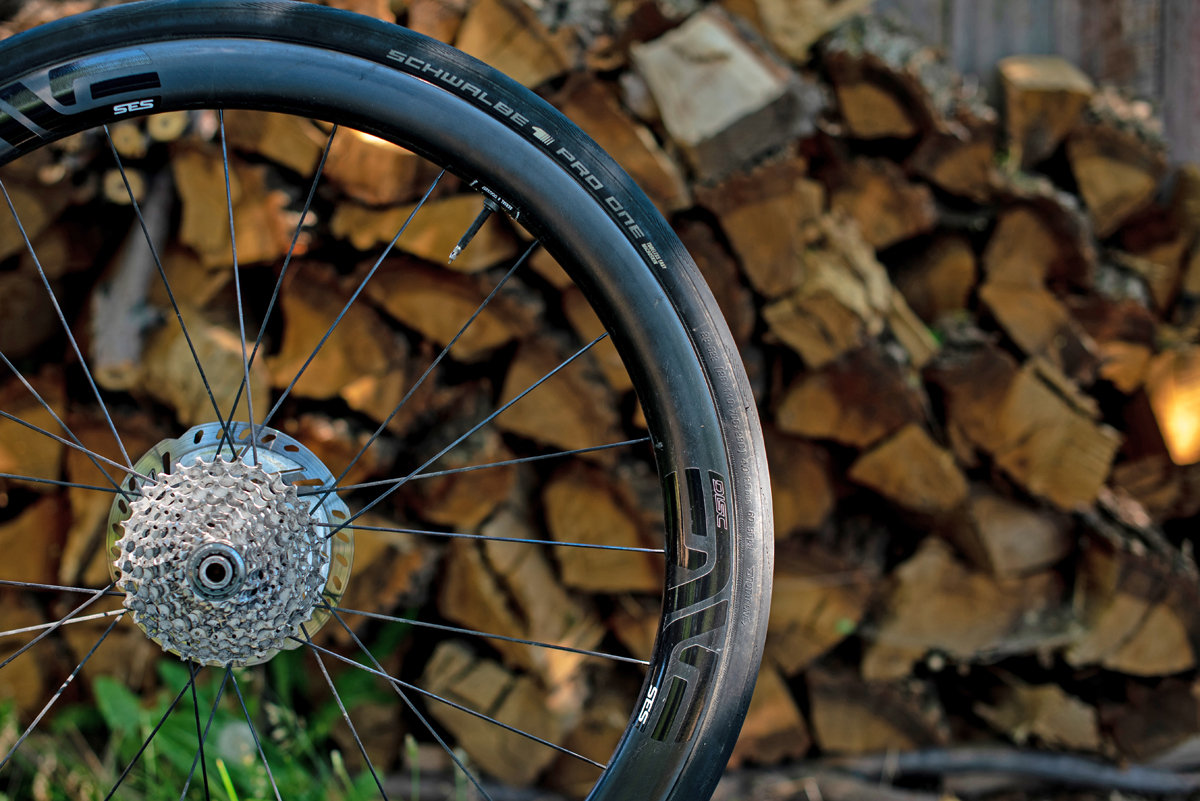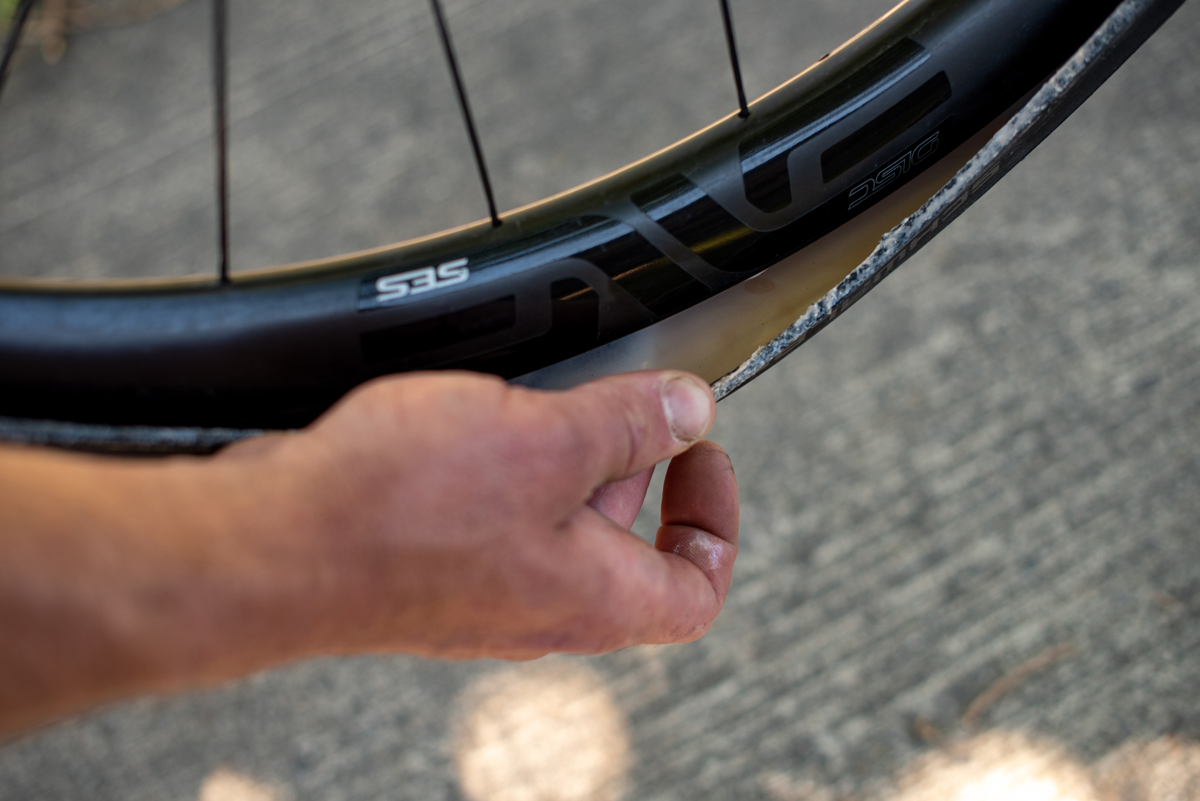By Chris Magerl – More comfort, fewer flats, better speed. Road tubeless comes down to that. It is truly a superior ride. Adoption of this technology has been slow, but there are some recent changes that might help riders get up to speed.

In the old days, you could spot the serious racer out training by seeing the spare sew-up, or tubular, tire strapped to the saddle rails with a leather toe strap. In the early ’80s, the ride quality of even cheap training sew-ups was so far superior to any clincher. But there were catches. If you flatted, you had to rip the glued-on tire/tube/casing combo off your rim, put on the new tire, and then gently work your way back home. Corners were questionable as you waited to roll that unglued spare off your rim. More than one flat and you were hitchhiking home, as there was no quick way to patch the flat in the field. If you did choose to patch at home, you had to peel the rim strip, cut the stitching that held the tire together, pull out a portion of the inner tube, patch, re-sew and re-glue. Yeah, I did this in college when I couldn’t afford a new sew-up, not even the cheap Cyrillic-stamped sew-ups Steve Tilford would sell us after his race trips to Eastern Europe.
I could buy 20 tubes for the cost of one of those mystery Tilford tubulars, and Steve’s were the lowest cost you could find. Eventually the convenience of clinchers won out, and sew-ups were relegated to race-day-only.
Fast-forward three decades, filled with continual riding and thousands of road miles. The first time I pedaled road tubeless, I was instantly drawn back to those hours on farm roads in Kansas in the early ’80s. Road tubeless was the best clincher ride I had ever experienced, no matter the tire, tube or wheel configuration. It was like training on sew-ups again.
Road buzz was reduced dramatically. I had to worry far less about flats, either from debris or pinch flats.
We are 20 years into commercially available tubeless road tires. Choices abound from a variety of manufacturers, including the biggest names in road cycling tires, many offering multiple widths. Wheel makers are designing in ways to make the most of these tires, including offering much wider rims and internal grooves that make all the difference in mounting tubeless tires.
A lot of hard-learned lessons have come in those 20 years. With help from Jake Pantone, Vice President of Product and Consumer Experience at Enve Composites of Ogden, Utah, we will help you get up to speed. Enve is an industry leader in the world of carbon bicycle components.
Should you make the switch?
“The technology is real and riders are going faster and in more comfort/confidence with this new technology,” according to Pantone. “The ride experience overall is too good to pass up.”
You can join the limitless online debate about whether tubeless is faster. There are so many elements that run counter to traditional bicycling thought about what is fast. Wider tires. Wider rims. Lower pressures. Can these really add up to a faster bike? But there is a real difference between testing on a drum in lab and riding on real roads with constant irregularities. Hit a pebble and your tire will either deflect (usually up and back, not the direction we want to go) or deform. Deforming keeps you moving forward. When you are on a chip-sealed road, you are hitting pebbles non-stop.
The pressure you run in a tube is not the right pressure for a tubeless tire. Many tire and wheel manufacturers have online charts that factor in rim internal width, tire width and rider weight, and then suggest the correct pounds per square inch, or psi. For longtime road riders, these are hard to believe.
“Our tire pressure chart is based off an algorithm and comparisons with real world feedback from riders of every size and ability,” says Pantone. “I’m all about 28mm tires and on a wide rim like the 3.4 AR, I generally run between 50-60 psi depending on the tire.”
“I ride with a lot of different people of every ability and size. I don’t know a single person running a tire smaller than 25mm and I don’t know anyone running above 90 psi and that includes several guys well north of 200 pounds,” says Pantone. “Tire pressure can really affect the overall ride experience so it’s important to get it right.”
These pressures are based on new, wider internal rim widths. The Enve 3.4AR wheels Pantone mentioned have an internal width of 25mm. Compare that with something like the old Mavic Open Pro, the standard of great alloy wheels for a generation, which has an internal width of 14.5mm. A 700 x 25 tubeless will have differing width and height dimensions and road characteristics on each of those rims.
With lower pressure, you will get less road buzz, less stiffness in your neck, fewer jolts to your wrists and elbows and shoulders, a much kinder saddle experience, and less soreness and vibration in your feet. Yup, it is that nice, assuming you don’t air up the tires like you always have.
We associate vibration with the sensation of speed, so it might take a bit to get over the feeling that you must be going slower. Resist the temptation to pump up to 95 psi. Trust your cycling computer to show you that you are covering the same terrain at quicker times. You won’t need the computer to tell you that you are doing so with more comfort.
Want to get in on this on the cheap? Your existing wheels are probably up to it. According to Stan’s NoTubes, most road wheels can be converted using their road tubeless bundle. There are loads of online tubeless tutorials. Remember that NoTubes has been doing this longer and better than anyone. Go to their site, take no shortcuts, and life will be peachy.
And your existing tires? Don’t even try! You can make almost any wheel and tire combo tubeless in the mountain bike world if you know a handful of tricks. In the road world, using anything other than a real tubeless tire is asking for a trip to the ER. Or worse.

Tubeless tires have very exacting specifications on tire bead diameter. Non-tubeless might set up, and might ride for a while. But you are going to end in catastrophic failure. Please, do not try this with non-tubeless road tires!
If you do try with your existing rim and real tubeless road tires, know that there will be trade-offs. A commonly heard refrain is that tubeless tires are almost impossible to put on or take off. That is true. And false.
Pantone explains how easy it can be on a modern rim designed for tubeless.
“A tubeless rim has a deep center channel and two shoulders. The shoulders are the surface on which the tire and rim create the air-tight seal. The center channel reduces the rim’s diameter, effectively allowing the tire to be installed. It is absolutely imperative that every single millimeter of tire bead be in that center drop channel when installing a tubeless tire. If not, you’ll fight it till your fingers are raw.”
Most wheel manufacturers offer some variation of this now. Watch the GCN guy mount Mavic tubeless tires on Mavic tubeless wheels with virtually no effort in his video “Have Mavic Nailed Tubeless for Road?” (This video is also fun to watch as he intentionally rides over increasingly large tacks to see what it takes to get the tire to fail.) I have mounted Hutchinson Fusion tubeless tires on NoTubes Alpha rims with no tire lever. Not because I had to, because it was easy to do.
But that very same Hutchinson Fusion tubeless tire on my favorite set of 12-year-old DT Swiss rims? Can be done, but it is a fight to the finish, even with a very strong lever. No center groove, which makes for a tough fit. But the ride is still sublime once the tire is mounted.
Remember, it is all about the ride quality. But you might also save weight. The new Continental Grand Prix 5000 TL, a highly anticipated tubeless update from the king of German tire makers, weighs 300 grams at 700 x 25. The standard version weighs 220 grams at 700 x 25. Add a high-end Continental tube (143 grams for the Race, 78 grams for the Race Light) and you are not paying a weight penalty for tubeless.
But wait, what about sealant? Sealant adds weight, and it is rotational weight a long way from the hub. Yup. BicycleRollingResistance.com tests have shown that 30 ml of sealant requires an additional 1 watt at 23 mph on a 700 x 25. You’ll get that watt back in reduced buzz and fatigue.
One other factor that needs to be mentioned is that rims, wheels, tires and frames have all been evolving quickly in reaction to disc brakes. Don’t buy a new frame for the disc brakes. Buy a new frame for the benefits that come with disc brakes.
“Disc brakes aren’t cool because of the stopping power they provide,” says Pantone. “They are cool because of what it allows us as a wheel manufacturer to create. The SES AR Series of wheels would have never been imagined in a rim brake world. There just wasn’t clearance available in a rim brake constrained frame. The amazing thing is that with this new wheel technology we get the best of everything: world-class aerodynamics, cross wind stability, lower rolling resistance, better cornering traction, all while riding in more comfort and confidence. Road riding has never been this fun.”









I switched to tubeless a couple years ago and have gotten so few flats, (one), that I have neglected to ck my tires for wear and have ridden a one down to the threads. I just never have to look at them, outta sight, outta mind. If you do switch, I recommend trying to remember to check tire wear at least once a month or so.
Surprised to see you conflate the advantages of wider, lower-pressure, tires with the advantages of tubeless. In the switch to disc brakes, riders can take advantage of larger, lower-pressure tires, and improve ride characteristics (and, depending on where you stand on the debate, faster speeds) as you note–but none of that depends on running tubeless.
Tubeless Road tyres are just about how to make cycling difficult. With wider tubed tyres the same benefit are realised without the hassle. If you puncture just put a tube in without the sealant mess. Yes if you puncture with tubeless you are going to need a tube…..
Comments are closed.